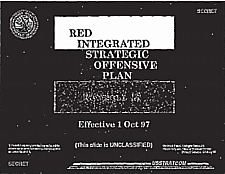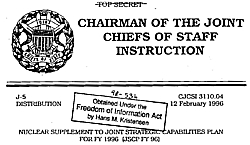The RISOP is Dead – Long Live RISOP-Like Nuclear Planning
 |
| Launch control officers at Minot Air Force Base practice launching their high-alert ICBM. But the hypothetical Russian nuclear strike plan that originally led to the requirement to have nuclear forces on alert has been canceled. So why are the ICBMs still on alert? |
.
By Hans M. Kristensen
The U.S. military has canceled the Red Integrated Strategic Offensive Plan (RISOP), a hypothetical Russian nuclear strike plan against the United States created and used for decades by U.S. nuclear war planners to improve U.S. nuclear strike plans against Russia.
The cancellation appears to substantiate the claim made by Bush administration and military official, that the 2001 Nuclear Posture Review removed Russia as an immediate contingency for U.S. nuclear strike planning. But implementing the shift was not a high priority, lasting almost the entire first term of the administration.
Despite the shift, however, declassified documents obtained under the Freedom of Information Act also show that RISOP-like and “red” analysis continues, and that that the cancellation was necessary to allow STRATCOM to broaden nuclear strike planning beyond Russia.
A Brief RISOP History
The RISOP dates back to the 1960s shortly after the first SIOP (Single Integrated Operational Plan), the Cold War name for the overall U.S. strategic war plan. An important element of refining and improving the effectiveness of the SIOP was to “wargame” it against the Soviet Union and more recently Russia. To do that, planners at Joint Staff and Strategic Air Command (SAC) developed a hypothetical Soviet War plan based on the latest intelligence about Soviet/Russian doctrine, strategy and weapons capabilities. To assist with coordination and planning, Joint Staff established the Red Planning Board (RPB), which included members of all the services and key agencies but was chaired by Joint Staff.
|
Figure 1: |
 |
|
RISOP updates coincided with SIOP updates. The following declassified (heavily redacted) briefings show the content and structure of the 1996, 1997 and 1998 RISOP plans: * Joint Staff RISOP-96 Brief, April 1995 |
RISOP was based on the latest intelligence about Soviet/Russian nuclear strategy and forces, but the declassified documents show that Joint Staff and STRATCOM did not consider it an intelligence appraisal of those capabilities. Nor did it represent a judgment on the most likely Russian geopolitical intentions. Instead, RISOP was described as one of many possible and plausible courses of action based on Defense Intelligence Agency estimates of Russia force employment consistent with their military doctrine. But since planners probably didn’t want to wargame SIOP against anything but the “real” threat, RISOP most likely was the best possible estimate of the Russian posture.
RISOP was primarily a U.S. nuclear war planning tool. As a detailed opposing force threat plan, it was used by SAC and later STRATCOM in computer simulations to evaluate updates to the SIOP plan; RISOP updates coincided with SIOP updates. RISOP was also used to conduct force structure, arms control, and continuity of government analysis, and to carry out communications studies and prelaunch survivability computations and other strategic analysis.
The Slow Wheels of Change
Responsibility for production of RISOP was transferred from Joint Staff to STRATCOM in late 1996. The RPB was maintained, however, to ensure, among other things, that STRATCOM didn’t “cook the books,” as one of the declassified briefings put it. But the 2001 Nuclear Posture Review (NPR) changed the planning assumptions against Russia. Whereas the RISOP plans of the late 1990s (see Figure 1) envisioned Russian nuclear attacks against the United States, its allies, and China, those assumptions were clearly out of sync with the political and military realities in Russia. The NPR instead determined that “a [nuclear strike] contingency involving Russia, while plausible, is not expected,” and that the size of the operational U.S. nuclear arsenal is “not driven by an immediate contingency involving Russia.” Thus, the overall planning assumption shifted from urgent to plausible.
|
Table 1: |
|
Dec 2001: NPR completed
|
But despite statements about the importance of ending the adversarial relationship with Russia, changing the nuclear planning against Russia apparently was not a priority and would have to wait almost the entire first term of the Bush administration. The NPR was completed in late 2001, the NPR Implementation Plan published in March 2003, the new Nuclear Weapons Employment Policy (NUWEP) signed in April 2004, and a new Joint Strategic Capabilities Plan nuclear supplement issued in December 2004, formally removing the requirement for the RISOP. Finally, in February 2005, four years and two months after the NPR, the Chairman of the Joint Chiefs of Staff issued the instruction that formally cancelled the RISOP and the RPB (see Table 1).
Despite the policy change toward Russia, the RPB had not made any changes to the RISOP since 1998, following President Clinton’s PDD-60 directive that removed the requirement to plan for protracted nuclear war with Russia. As one Joint Staff official remarked in an email: “Sometimes the wheels of change move slowly.”
The “New” Nuclear Planning
The new planning guidance was laid out in the nuclear supplement to the Joint Strategic Capabilities Plan (JSCP), formally known as CJCSI 3110.04B or JSCP-N (see Figure 2 for earlier JSCP-N), which was published on December 31, 2004. This document instructed STRATCOM to “perform broader campaign level analysis than the previous requirement which focused on the RISOP.” In the words of the RPB, STRATCOM’s “red attack plan may also be broader than the scope of the RISOP.”
|
Figure 2: |
 |
|
|
This broadening probably reflects the efforts to expand strike planning beyond Russia with increased focus on China and regional states armed with weapons of mass destruction (WMD). A “notable change” for the strike plan put in effect in March 2003 (OPLAN 8044 Revision 03) included executable strike options against regional states, options that were probably carried forward into the current OPLAN 8044 Revision 05.
Of course, Russia didn’t just disappear from the planning requirements. The NPR itself warned that although the country no longer is considered an immediate contingency, “Russia’s nuclear forces and programs, nevertheless, remain a concern. Russia faces many strategic problems around its periphery and its future course cannot be charted with certainty.” The NPR concluded that “U.S. planning must take this into account.” In addition, the NPR hedged, “in the event that U.S. relations with Russia significantly worsen in the future, the U.S. may need to revise its nuclear force levels and posture.” Relations have certainly not improved.
The previous JSCP-N from January 2000, which was updated in July 2001 (see here for chronology of nuclear guidance), required Defense Intelligence Agency (DIA) and Defense Information Systems Agency (DISA) to provide information to the Joint Staff for use in RISOP development. But the new JSCP-N moved this role to STRATCOM by directing that DIA and DISA “will support USSTRATCOM directly by providing data for red analysis.” The JSCP-N directs STRATCOM to perform three levels of analysis for the strike plans:
Phase I: Consequence of Execution Analysis
Phase II: Campaign Level Analysis
Phase III: Intelligence Assessment Analysis
Campaign Analysis is “a campaign level analysis to provide a stochastic check of the deterministic models used for the revision report consequences of execution analysis and to assess OPLAN 8044, REVISION XX’s [formerly SIOP] capability to comply with approved guidance. Such analysis will encompass various scenarios and may include the potential contribution of SACEUR’s MCOs [Major Combat Operations] as required.”
Despite the cancellation of RISOP, a 2004 STRATCOM briefing stated, STRATCOM “will continue to produce RISOP-like analysis,” and “procedures for requesting data and providing products will remain the same.” As before, use of the data will support prelaunch survivability analysis for ICBMs and bombers, base survivability of SSBN bases, and command, control and communication vulnerability and survivability analysis. All to ensure that U.S. nuclear forces will survive and endure against any nuclear adversary, including Russia.
Comments
U.S. nuclear forces were placed on high alert to counter the Soviet nuclear threat, and the effectiveness of the strike plan for their potential use continuously refined and improved by wargaming it against the RISOP. Now that Russia is not considered a nuclear threat and the RISOP has been canceled, how long will it be before the alert posture is canceled as well?
The U.S. strategic war plan – OPLAN 8044 Revision 05 – is currently structured around a reduced but more flexible posture with the same overall Triad structure as during the Cold War and over 1,000 nuclear warheads on high alert. Surprisingly, although RISOP was canceled in 2005, no revision has been made to OPLAN 8044 since October 2004 – the first time in U.S. post-Cold War nuclear history that the nation’s strategic war plan has not been overhauled at least once per year (see Figure 3).
|
Figure 3: |
 |
| STRATCOM has not published an updated U.S. strategic war plan since October 2004, breaking with a historical pattern of annual overhauls. The change probably reflects development of a new plan structure and more flexible adaptive planning capabilities. |
.
The explanation might be that major overhauls are no longer necessary because today’s plan has become flexible enough to accommodate changes on a ongoing basis without a need for a new revision; a “living SIOP.” OPLAN 8044 now consists of a family of plans applicable in a wider range of scenarios, with more flexible options to defeat adversaries in a wider range of contingencies than during the Cold War. Cancellation of RISOP might have reduced the focus on Russia, but it was also part of a broadening of nuclear strike planning to other potential adversaries.
The s l o w cancellation of the Russian-focused RISOP and the continuation of RISOP-like and red nuclear war planning for a broader and more flexible war plan should be an important lesson for the next president: unless he keeps his eye on the issue and pays continuous attention to how and when the military translates his initial guidance into a myriad of war planning requirements and strike options, the future U.S. nuclear posture – and with it the hope of significantly reducing the role and salience of nuclear weapons in the world – will only change v e r y slowly and not necessarily in the direction he had intended.
The FY2026 National Defense Authorization Act (NDAA) paints a picture of a Congress that is working to both protect and accelerate nuclear modernization programs while simultaneously lacking trust in the Pentagon and the Department of Energy to execute them.
While advanced Chinese language proficiency and cultural familiarity remain irreplaceable skills, they are neither necessary nor sufficient for successful open-source analysis on China’s nuclear forces.
Satellite imagery has long served as a tool for observing on-the-ground activity worldwide, and offers especially valuable insights into the operation, development, and physical features related to nuclear technology.
This report outlines a framework relying on “Cooperative Technical Means” for effective arms control verification based on remote sensing, avoiding on-site inspections but maintaining a level of transparency that allows for immediate detection of changes in nuclear posture or a significant build-up above agreed limits.